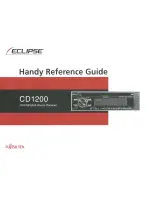
7
Rev.2.10
[5]
Control terminals
8-pin and 7-pin Euro blocks are used.
The following terminals are equipped.
E1 CNT: provides E1 signal * output controlled by K-STD14 (Teacher Microphone).
E2 CNT: provides E2 signal * output controlled by K-STD14.
* Those are available when K-STD14 is used. Settings of E1 and E2 are performed with K-STD14.
E2 ACK: connects acknowledge signals responding to E2 output.
PAGE MUTE: provides “make signal” inputs externally when the paging function is used.
RS-232C: is used to control this unit via communication from an external device.
LINK button: provides “make signal” inputs externally when the external link button is used.
Alert Notification Button: provides “make signal” inputs externally when the external Alert Notification Button is used.
[6]
Amplifier interface connector
This connector is used to connect the cable to the amplifier.
A standard CAT5 or CAT5e cable is used to connect to the amplifier.
[7]
MIX OUT (unbalanced) connector
The LINE IN connector provides audio output for other media players. Setting the No. 4 of the DIP switch 1 to ON allows the
audio outputs of the microphone MIC1 and MIC2 received by this unit to be provided after mixing with LINE IN. This is an
unbalanced output. A stereo mini plug (φ3.5 mm) is used.
[8]
LINE IN connector
This connector is used to provide an audio input from external sources such as a projector or CD. This is a stereo, line level
input, and is internally mixed to a monaural signal. A stereo mini plug (φ3.5 mm) is used.
[9]
DIP Switches
Two DIP switches are used.
The settings of this switch are updated when the receiver powers on.
Settings changed while powered on are not updated until the receiver is restarted. (Excluding No.7 of DIP Switch 1)
[10]
Screw cover
This screw cover is used when doing the ceiling and wall mounting installation. Open this screw cover and screw on a
mounting plate.








































